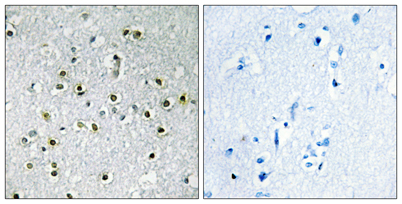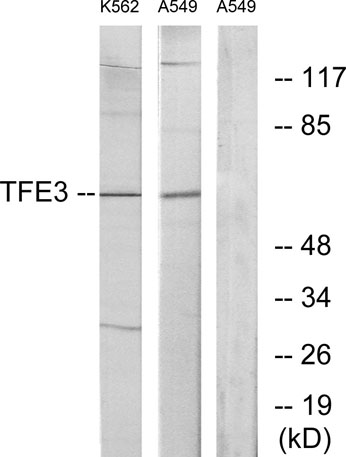| Product name: |
TFE3 rabbit pAb |
| Reactivity: |
Human;Mouse |
| Alternative Names: |
TFE3; BHLHE33; Transcription factor E3; Class E basic helix-loop-helix protein 33; bHLHe33 |
| Source: |
Rabbit |
| Dilutions: |
Western Blot: 1/500 - 1/2000. Immunohistochemistry: 1/100 - 1/300. ELISA: 1/20000. Not yet tested in other applications. |
| Immunogen: |
The antiserum was produced against synthesized peptide derived from human TFE3. AA range:101-150 |
| Storage: |
-20°C/1 year |
| Clonality: |
Polyclonal |
| Isotype: |
IgG |
| Concentration: |
1 mg/ml |
| Observed Band: |
62kD |
| GeneID: |
7030 |
| Human Swiss-Prot No: |
P19532 |
| Cellular localization: |
Cytoplasm, cytosol . Nucleus . When nutrients are present, phosphorylation by MTOR prevents nuclear translocation and activity (PubMed:22692423, PubMed:30733432). Conversely, inhibition of mTORC1, starvation and lysosomal disruption, promotes dephosphorylation and translocation to the nucleus (PubMed:22692423, PubMed:30733432). . |
| Background: |
This gene encodes a basic helix-loop-helix domain-containing transcription factor that binds MUE3-type E-box sequences in the promoter of genes. The encoded protein promotes the expression of genes downstream of transforming growth factor beta (TGF-beta) signaling. This gene may be involved in chromosomal translocations in renal cell carcinomas and other cancers, resulting in the production of fusion proteins. Translocation partners include PRCC (papillary renal cell carcinoma), NONO (non-POU domain containing, octamer-binding), and ASPSCR1 (alveolar soft part sarcoma chromosome region, candidate 1), among other genes. Alternative splicing results in multiple transcript variants. [provided by RefSeq, Aug 2013], |




 Immunohistochemistry analysis of paraffin-embedded human brain tissue, using TFE3 Antibody. The picture on the right is blocked with the synthesized peptide.
Immunohistochemistry analysis of paraffin-embedded human brain tissue, using TFE3 Antibody. The picture on the right is blocked with the synthesized peptide. Western blot analysis of lysates from K562 and A549 cells, using TFE3 Antibody. The lane on the right is blocked with the synthesized peptide.
Western blot analysis of lysates from K562 and A549 cells, using TFE3 Antibody. The lane on the right is blocked with the synthesized peptide.在線咨詢
技術(shù)支持



 下載說明 ①
下載說明 ①


